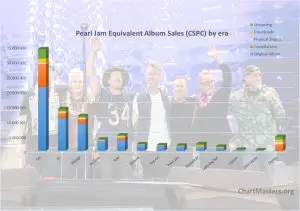Forum
Pearl Jam is a name synonymous with the rise of grunge and alternative rock in the early 1990s, emerging from the vibrant Seattle music scene alongside bands like Nirvana, Soundgarden, and Alice in Chains.
Today, we review their sales and streaming statistics, to really grasp how popular they have been and still are.
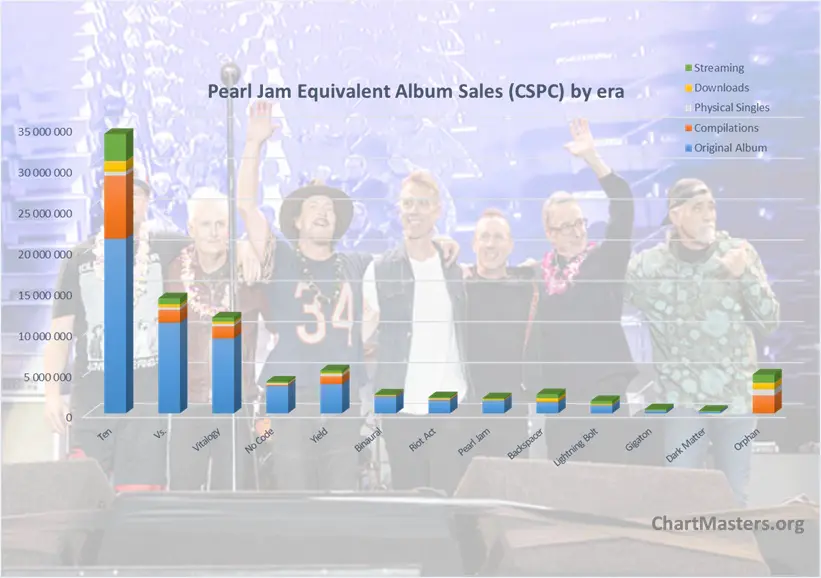
Looking at the big picture: Pearl Jam
The origins of Pearl Jam
Pearl Jam’s origins can be traced back to the tragic end of Mother Love Bone, a promising Seattle band whose charismatic frontman, Andrew Wood, passed away from a heroin overdose in 1990. The band’s guitarist, Stone Gossard, and bassist, Jeff Ament, were left grappling with the loss and the uncertainty of their musical futures. Together since 1984 and the band Green River, the pair looked for new solutions to pursue their dreams. They recruited guitarist Mike McCready, whose blues-influenced playing complemented Gossard’s riff-driven style.
The trio recorded instrumental demos in an effort to form a new band. These tapes eventually made their way to San Diego, where Eddie Vedder, a surfer and vocalist, listened to them. Inspired by the music, Vedder wrote lyrics and recorded vocals for three of the tracks, which would later become Alive, Once, and Footsteps. Vedder’s heartfelt lyrics and distinctive voice impressed Gossard, Ament, and McCready, leading to his invitation to join the band. With the addition of drummer Dave Krusen, the group solidified its lineup and initially called themselves Mookie Blaylock, after the NBA player. However, due to trademark concerns, they later adopted the name Pearl Jam.
The breakthrough: Ten
Pearl Jam’s debut album, Ten, released on August 27, 1991, marked their official entry into the music world. The album featured a polished production style, which stood in contrast to the rawer sounds of other Seattle bands. It included tracks like Alive, Even Flow, and Jeremy, each showcasing Vedder’s introspective lyrics and the band’s ability to blend powerful riffs with emotive melodies.
Although Ten had a slow start on the charts, it gained momentum over the course of 1992, thanks in part to relentless touring, music videos on MTV, and word-of-mouth popularity. By the end of the year, it had become one of the defining albums of the grunge era. Commercially, Ten was a massive success, eventually being certified 13x Platinum by the RIAA in the United States.
One of the most enduring songs from the album, Jeremy, earned widespread acclaim for its poignant exploration of teenage isolation and violence. The accompanying music video, which depicted the emotional struggles of a young boy, won multiple MTV Video Music Awards in 1993. Album cut Black also became a significant hit on its own. However, the band’s relationship with the mainstream media grew increasingly strained, even as their fame soared.
Maintaining momentum: Vs. and Vitalogy
Following the success of Ten, Pearl Jam faced the challenge of creating a follow-up that would both meet expectations and stay true to their artistic vision. Their second album, Vs., released in October 1993, saw the band taking a more aggressive and less polished approach. Tracks like Go, Animal, and Daughter illustrated the band’s evolving sound and willingness to experiment.
Commercially, Vs. was an immediate success, debuting at No. 1 on the Billboard 200 and selling a record-breaking 950,000 copies in its first week in the United States. The album stayed at the top of the charts for five consecutive weeks and has since been certified 7x Platinum. Despite its commercial success, Pearl Jam’s increasing reluctance to embrace the trappings of fame became evident. They declined to release music videos for the album’s singles and grew more selective about media appearances.
Their third album, Vitalogy, arrived in late 1994 and continued the band’s trend of pushing boundaries. The record blended grunge, punk, and experimental elements, resulting in a more eclectic sound. Songs like Better Man, Corduroy, and Spin the Black Circle highlighted the band’s range, from heartfelt ballads to high-energy anthems. Like its predecessor, Vitalogy debuted at No. 1 and sold 877,000 copies in its first week, the second highest score of the Soundscan era up to that point. It has since been certified 5x Platinum in the United States.
The fight against Ticketmaster
In the mid-1990s, Pearl Jam’s ethos of integrity and commitment to their fans led them into a public battle with Ticketmaster, the dominant ticketing company at the time. The band accused Ticketmaster of monopolistic practices and high service fees, which they believed exploited fans. They attempted to organize a tour using non-Ticketmaster venues, but the logistical challenges proved immense.
While the battle gained Pearl Jam significant respect as artists who prioritized their audience over profit, it also took a toll on the band’s touring schedule and public visibility. Their fight against Ticketmaster showcased the complexities of navigating the music industry as one of the world’s biggest bands while staying true to their principles.
Changing sounds and lineups
The late 1990s saw Pearl Jam innovate further with their sound and navigating changes within the band. Drummer Dave Krusen had left shortly after the recording of Ten and was replaced by Dave Abbruzzese, who played on Vs. and Vitalogy before being replaced by Jack Irons. The band’s fourth album, No Code (1996), marked a departure from their earlier work, featuring a more introspective and creative style. While it debuted at No. 1, its sales declined more quickly than their previous albums, reflecting a shift in their audience and the broader music landscape.
Their fifth album, Yield (1998), saw a partial return to their earlier sound and was more warmly received by fans and critics. The record included standout tracks like Given to Fly and Do the Evolution, the latter of which became notable for its animated music video, one of the few the band released during this period.
A new millennium: reinvention and stability
As the 2000s began, Pearl Jam continued to build their legacy, focusing on their devoted fanbase and touring extensively. Their sixth album, Binaural (2000), and their seventh, Riot Act (2002) were added to their catalog. Like their previous records, they addressed political and personal turmoil, with the latter covering the September 11 attacks.
By this time, drummer Matt Cameron, formerly of Soundgarden, had joined the band, solidifying a lineup that remains intact to this day. Riot Act received mixed reviews but further established Pearl Jam as a band unafraid to tackle challenging themes.
At the start of the 2000s, Pearl Jam launched their first official bootlegs. To counter the sales of lower-quality unauthorized recordings, the band independently released every performance on CD. Over the years, hundreds of these live albums were issued, selling millions of copies in total.
In 2006, Pearl Jam released a self-titled album often referred to as the Avocado album due to its cover art. This album marked a return to a more straightforward rock sound, with tracks like World Wide Suicide and Life Wasted receiving critical acclaim. It debuted at No. 2 on the Billboard 200 and reaffirmed the band’s relevance in the changing music landscape.
2009's Backspacer became their first US No. 1 album since 1996's No Code and what's more, Just Breathe became an organic rock hit and still remains one of their strongest tracks.
Later years
During the 2010s, Pearl Jam embraced their role as elder statesmen of rock. Their 2013 album, Lightning Bolt, also debuted at No. 1 and featured a mix of reflective ballads and high-energy rock tracks, including Mind Your Manners and Sirens. The album earned them a Grammy Award for Best Recording Package, a natural prize given their attention to artistry and details beyond just music.
Throughout the decade, Pearl Jam became known for their epic live performances, including marathon sets and deep-cut-heavy setlists. Their commitment to environmental and social causes also remained a cornerstone of their identity. They were inducted into the Rock and Roll Hall of Fame in 2017.
Pearl Jam’s 2020 album, Gigaton, arrived amidst the global COVID-19 pandemic, featuring tracks like Dance of the Clairvoyants and Superblood Wolfmoon. Despite the challenges of touring during the pandemic, Pearl Jam adapted by engaging with fans through virtual performances and delayed tours. Their last effort Dark Matter arrived in 2024, along with the Dark Matter World Tour. They've now performed more than 1,000 concerts.
Commercial success in retrospect
While Pearl Jam’s initial albums achieved massive commercial success, their later work solidified their reputation as a band committed to artistic growth and longevity rather than chasing hits. By the end of the 1990s, they had sold tens of millions of albums worldwide, with Ten remaining their best-selling record. The band’s decision to prioritize creative freedom over commercial expectations ensured their continued relevance, even as the grunge movement faded and the music industry evolved.
Their great image among rock fans and the recurring airplay of classic tracks like Alive or Even Flow enables them to continue to sell a decent amount of albums every year. This article will dig into the figures, to truly reflect on their popularity overall, and the success of each of their era.
Pearl Jam album sales

Updated studio album sales & comments
First released over 30 years ago, Ten continues to sell steadily year after year. In the US, it closed the 1990s with just over 11 million copies sold, a total that has now surpassed 14 million. While it remains certified 13× Platinum based on its last RIAA award in 2009, with track-equivalent and stream-equivalent units, it is now eligible for 15× Platinum.
Initially selling under a million copies during its promotional campaign, the album gained even more traction over time in Europe, where it has now topped 3.6 million sales. A similar story unfolded in Latin America, Japan, and Oceania, bringing its global total to a massive 21.4 million.
Vs. and Vitalogy weren’t far behind in their first two years, though they naturally lack the enduring catalog strength of their iconic predecessor. Still, they have sold over 11 million and 9 million copies, respectively - impressive figures by any standard.
The band’s departure from the mainstream spotlight is reflected in No Code's numbers, though its absolute sales remain strong, comfortably surpassing 3 million. Yield performed similarly well.
From 2000 to 2013, Pearl Jam’s album sales gradually declined, just like the whole market, but at a slow pace, starting with the 2-million-selling Binaural and continuing through to the million-selling Lightning Bolt. With the shift toward streaming, Gigaton (310,000 units) and Dark Matter (200,000) were purchased almost exclusively by dedicated fans.
Overall, Pearl Jam has sold more than 56 million studio albums throughout their career.
Want to compare the act's albums with others?
Pearl Jam songs sales
Below, we list down results from the artist through physical sales, digital sales and streaming.
Please be aware that when the artist is regarded as the lead act, they are rewarded with 100% of these units. However, featured acts share a 50% piece of the total.
Physical singles
By the 1990s, rock fans had largely abandoned the habit of buying physical singles. Pearl Jam was no exception, especially since they never prioritized singles in their marketing strategy. This led to an unusual situation - when they first entered the Billboard Hot 100 on November 19, 1994, with Tremor Christ / Spin the Black Circle debuting at #58, Ten and Vs. had already accumulated 13 Platinum certifications combined.
Even more surprising, their singles became somewhat of collectors' items in the 1990s, often lingering on the Bubbling Under chart for years. As a result, even modest chart performers like Jeremy (#79 peak) managed to sell over 500,000 copies in the US. In the UK, their singles achieved higher peaks - #15 for Jeremy, #16 for Alive, and #27 for Even Flow - but in a fast-moving market where songs typically debuted high and dropped out quickly.
Despite their singles' lack of strong chart performances, those from the early '90s still racked up significant sales worldwide. Jeremy sold close to 700,000 copies, while Alive, Go, Daughter, Spin the Black Circle (#10 in the UK), and Not for You each moved around 400,000. Meanwhile, Even Flow, Animal, Oceans, and Immortality each sold roughly 200,000 copies.
The Merkinball EP, featuring I Got Id and Long Road, became their first US top 10 hit (#7) and sold over 850,000 copies worldwide. Who You Are (400,000+), Given to Fly (600,000+), and Wishlist (300,000+) were solid sellers from No Code and Yield as well.
Pearl Jam’s biggest hit as a single came in support of Kosovo War refugees. Last Kiss climbed to #2 on the Hot 100, spending 10 weeks inside the top 10 and selling 1.2 million copies globally.
With the collapse of the U.S. single market in the early 2000s, only I Am Mine managed to surpass six-digit sales, reaching 200,000 copies.
For a band that took years to chart its first single, selling over 8 million units in this format is an impressive feat.
Digital songs
Most major acts from the 1990s have one defining signature song - Creep for Radiohead, Wonderwall for Oasis, Wannabe for the Spice Girls, among others - along with a couple of lasting hits. Pearl Jam’s case is different. They don’t have a single dominant track, but instead, no fewer than eight songs with digital sales comfortably surpassing a million.
Their top three best-sellers all come from Ten. Even Flow and the remarkable album cut Black are virtually tied, each surpassing 2 million sales. Not far behind is Alive, while the album’s top physical single, Jeremy, follows with nearly 1.5 million copies sold.
Interestingly, Jeremy’s CD single contained a B-side that became a Pearl Jam classic in its own right. Yellow Ledbetter, originally left off Ten, has since amassed 1.7 million digital sales. Other strong performers include Last Kiss (1.5 million) and Better Man (1 million), with Daughter also holding up well at over 700,000.
Their most recent million-seller, Just Breathe, benefited from the download era, reaching 1.7 million sales following its 2009 release on Backspacer.
Altogether, Pearl Jam has sold 24 million downloads and ringtones.
Streaming
Audio Streams
– South Korea: Genie streams * 2.20 (consistent with Gaon streaming numbers)
– Japan: AWA streams * 100 / 4 (AWA has 4% of the Japanese streaming market)
– Arabic world: Anghami streams
– Sub-Saharan Africa: Boomplay + Audiomack streams
– Elsewhere: Spotify streams * Spotify market shares based on artists' market distribution
Video Streams
– China* : QQ video streams * 50 if the song is available for audio stream, QQ video streams * 5 elseway (scale built based on known figures for several major artists)
– Elsewhere : Youtube views increased by 10% to account for various local platforms
*since Chinese streaming platforms are mostly video streaming platforms, their streams are weighted on par with YouTube streams.
Audio Stream value – 1,500 plays equal 1 album unit
Video Stream value – 6,750 views equal 1 album unit
Equivalent Albums Sales (EAS) = ( Spotify * ArtistRatio + Genie * 2.20 + AWA * 100 / 4 + Anghami + Boomplay + Audiomack ) / 1500 + ( QQ views* 50(or 5) + YouTube * 1.1 ) / 6750
Top hits
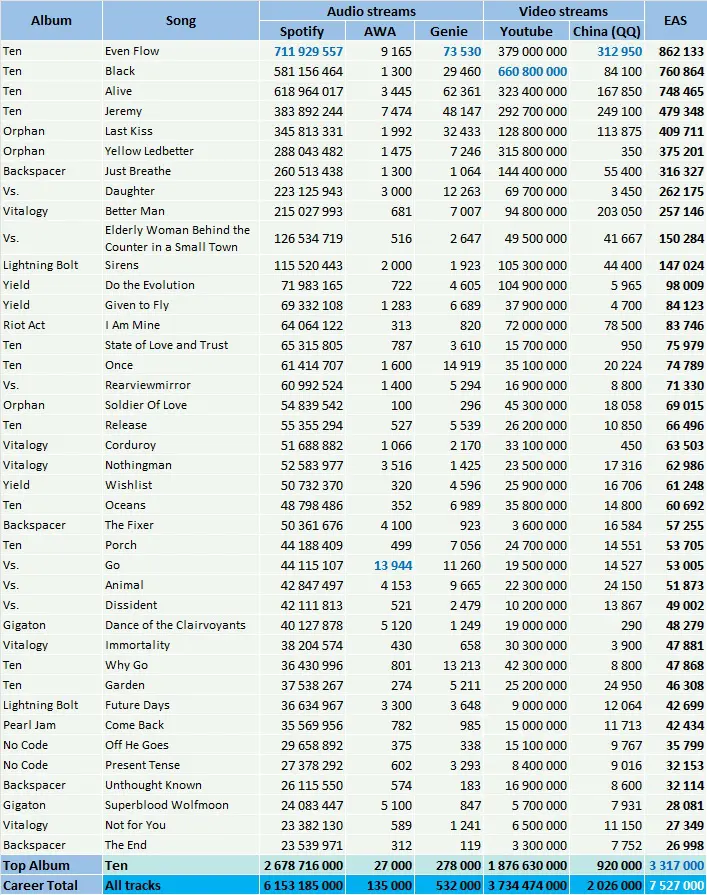
The usual suspects dominate the list of Pearl Jam’s most streamed songs, with Ten's classics Even Flow, Black, Alive and Jeremy leading the charge. The first three are particularly impressive, averaging over 600 million streams each on Spotify and combining for 1.3 billion views on YouTube.
Jeremy follows, leading the tracks in the 215-385 million range on Spotify, ahead of Last Kiss, Yellow Ledbetter, Just Breathe - a late-career standout - Daughter and Better Man.
From their later catalog, Sirens tops 100 million, with The Fixer surpassing 50 million. Dance of the Clairvoyants, Future Days, Come Back, Unthought Known, Superblood Wolfmoon and The End also feature in th top 40.
Pearl Jam's discography reflects remarkable consistency, amassing over 6 billion streams on Spotify, despite their top song capping at 700 million.
Full catalog breakdown
If you are familiar with the artist's catalog and want to check details of each and every song, you can access to all of them right here.
Keep yourself up to date
Our website provides you a fantastic tool which fetches updated Spotify streams as you request them, use it to watch these results grow day after day!
Pearl Jam compilations sales
Assigning compilation sales to original studio albums

How do you understand this table? For example, if we check the Rearviewmirror (Greatest Hits 1991-2003) line, these figures mean it sold 2,860,000 units worldwide. The second statistics column means all versions of all the songs included in this package add for 5,380,767 equivalent album sales from streams across all formats.
The second part (on the right of the table) shows how many equivalent streams are coming from each original album, plus the share it represents in the overall package.
Therefore, the streaming figures convey that songs from Ten equate to 56% of Rearviewmirror (Greatest Hits 1991-2003)'s tracklist attractiveness. Meaning, it generated 1,595,000 of its 2,860,000 album sales and so on for the other records.
Raw compilations sales
Pearl Jam doesn’t have any truly massive-selling compilations, and there are two main reasons for this. The first is timing. The band’s career began in the 1990s, and by the time their first major greatest hits collection was released in 2004, album sales were already in decline, and iTunes had ushered in the era of cherry-picking individual tracks. This significantly reduced the appeal of traditional compilations.
The second reason ties back to the previous section: with their three biggest hits featured on Ten, the album already functioned as a de facto greatest hits collection.
Still, Rearviewmirror (Greatest Hits 1991–2003) sold close to 3 million copies, while the preceding Lost Dogs, which compiled key outtakes, moved nearly 1 million. The 2011 release Twenty added over 300,000 sales.
Pearl Jam’s highly acclaimed live albums have played a much bigger role in their compilation sales. Dissident: Live in Atlanta sold over 600,000 copies, while their first full live album, Live on Two Legs, moved nearly 2 million. Other notable releases include Oct. 22, 2003 – Benaroya Hall (500,000), Live on Ten Legs (215,000), Let’s Play Two (75,000), and MTV Unplugged (140,000). Additionally, their 300+ official bootlegs contribute a substantial 4.4 million sales.
Live material also dominates their video sales, with Pearl Jam’s music videos totaling 1.7 million copies sold.
Re-assigned compilation sales – Results & comments
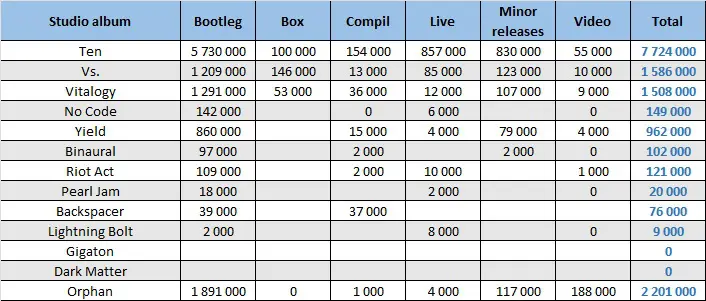
Bonus: Top selling compilations’ breakdowns
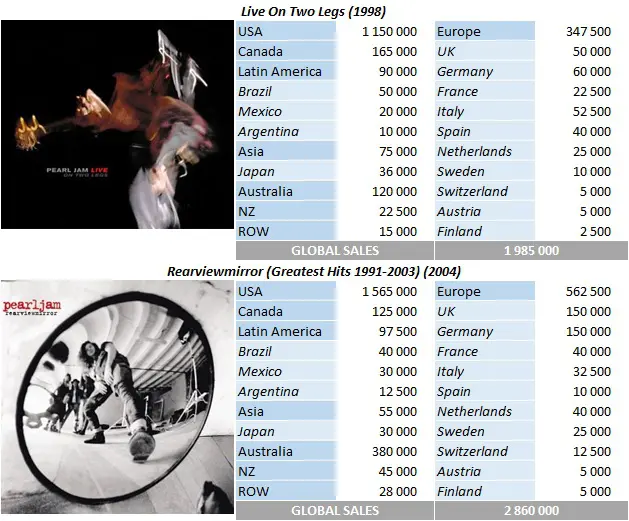
Bonus: Total album (all types) sales per country
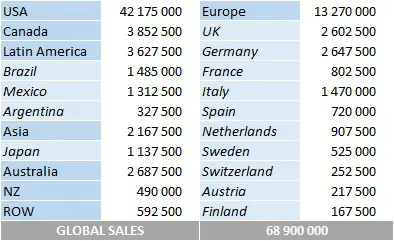
Please note country-specific numbers may miss sales of a few minor releases, although totals are complete.
Pearl Jam: career results (CSPC)

Albums results (CSPC)
In the following results table, all categories display figures in equivalent album sales. If different, pure sales are listed between parentheses.
As a reminder:
- Studio Album: sales of the original album
- Other Releases: sales of compilations generated thanks to the album
- Physical Singles: sales of physical singles from the album (ratio 3/10)
- Download Singles: sales of digital singles from the album (ratio 1,5/10)
- Streaming: equivalent album sales of all the album tracks (ratio 1/1500 for Audio stream and 1/6750 for Video stream)
Artist career totals
See where the artist ranks among remaining singers
Unsurprisingly, Ten leads the way as Pearl Jam’s biggest album - and it does so in spectacular fashion, with 34 million equivalent album sales across all metrics. It ranks as the third biggest rock-band album of the 1990s, trailing only Nirvana’s Nevermind and Metallica’s self-titled album.
Vs. and Vitalogy round out a strong podium, with both albums comfortably surpassing 10 million sales. Together, they account for a combined 25 million units. Following them is Yield with 5 million, while No Code is close behind with nearly 4 million.
Albums from the 2000s, namely Binaural, Riot Act, Pearl Jam, and Backspacer, average around 2 million sales each, while Lightning Bolt has reached 1.5 million. More recent releases, such as Gigaton (500,000) and Dark Matter (300,000), would require viral hits or steady streaming growth to match the commercial performance of their predecessors.
Altogether, Pearl Jam’s career total is slowly but surely inching towards 85 million equivalent album sales, a highly respectable tally that puts them firmly among the top rock bands from the 90s.
Additionally, frontman Eddie Vedder’s debut solo album, Into the Wild, has developed a cult following, achieving an impressive 3 million equivalent album sales after a slow start.
Singles results (CSPC)
Want to compare the act's songs with other top hits?
Discography results (ASR)
Thanks to our new ASR (Artist Success Rating) concept, we know that sales represent 0.00 million times the purchase of entire discography. Coupled with total sales, it translates into an ASR score of . The ranking of all artists studied so far is available too at this link.
Records & achievements
- At 34,168,000 EAS, Ten is the 4th most successful album from 1991.
- At 34,168,000 EAS, Ten is the 3rd most successful rock album by a group from the 1990s.
- At 14,066,000 EAS, Vs. ranks among the 20 most successful albums of 1993.
- At 11,721,000 EAS, Vitalogy ranks among the 20 most successful albums of 1994.
- At 950,378 copies, Vs. owned the biggest debut of the Soundscan era in the US until 1998.
- At 877,000 copies, Vitalogy recorded the second biggest debut of the Soundscan era up to its release.
- At 73,013,000 EAS, Pearl Jam owns the 3rd highest selling catalog by a rock band in the 1990s.
- At 84,540,000 EAS, Pearl Jam ranks 4th among rock bands that broke over during the 1990s.
Dynamic Spotify key performance indicators
Current followers count: 0 >> Daily breakdown
Current streams count: 0 >> Daily breakdown
is #0 among the most streamed artists of all-time Popularity Rating: /100 >> Visit our Top 1,000 most streamed artists ranking >> Visit our Top 20 highest rated artists ranking
Current monthly listeners: 0 (Trend: 0) Global chart position: N/A The artist top 50 cities come from 0 distinct countries >> Global impact breakdown
As usual, feel free to comment and / or ask a question!
Sources: IFPI, Spotify, YouTube, Discogs.
You may be interested in...
... Pearl Jam's streaming masters analysis
... checking out the upcoming artists or even voting for them!
... similar artists
... best-selling artists, albums, and singles
Album Ten 34 167 000 EAS or in records is number 32 000 000 EAS?
Total EAS is 84 539 000 or in records is number 82 000 000 EAS?
Hi Meca76! Thanks for pointing that out, we've edited those totals to the correct ones.
Thank you very much, it was a pleasure. I appreciate your great work. Mistakes happen, and I was very happy to point it out to you.
Thanks so much for this. Ten is about where I was expecting, but their total of 84 million is higher than I thought!
Thanks for this article, so much detail and work has gone into it. I love their first 7 albums but Ten and Vs were unbelievable records that I still listen to to this day.
I'm really happy to see one of my favorite bands being discussed here. As for the analysis itself, it just confirms some suspicions I already had:
In the '80s, the whole Hair Metal scene always felt more like an American thing to me. Bands like Bon Jovi, Def Leppard, Poison, and Mötley Crüe sold gazillions of records in the U.S., but I never saw them as a truly global phenomenon. In Europe, the biggest acts in the early '80s were The Police and Pink Floyd, while later in the decade, U2, Depeche Mode, and Dire Straits took over. Even within the heavier rock scene, the bands that felt truly massive to me were Scorpions, Judas Priest, and Iron Maiden—not Van Halen or Metallica.
Then we get to the whole Grunge movement, which was basically a minimalist response to Hair Metal. Looking at the sales certifications for Grunge bands, it doesn’t surprise me that it was more of a North American phenomenon than a global one—since, after all, it was a reaction to Hair Metal, which was itself a mostly American phenomenon.
As for Pearl Jam, I’m not surprised they became the most successful Grunge band in North America. Not only did Ten have several radio hits, but they also did extensive touring to promote it, and over the years, they built an incredibly solid discography.
I see Nirvana more as the exception rather than the rule when it comes to Grunge. They were truly a global phenomenon. I already knew Pearl Jam was bigger in the U.S., but I was curious to see if the difference was big enough for them to be considered the biggest Grunge band overall. Unfortunately, the answer is… no. Nirvana is still the biggest, but I personally consider Pearl Jam the better band. Their discography has more highs than lows, especially compared to Nirvana’s tiny catalog.
Nirvana has that "mystique" due to the suicide of Kurt plus how his death has been romanticized by both the media and Nirvana fans("he died for his art!"). My family comes from South Asia. Many of them don't care about rock music but they LOVE Nirvana. That's how huge that band was. Pearl Jam cannot compete with that but I do consider them the superior band too. Their albums and songs are far more diverse. Actually, I think all of the the big grunge bands (Pearl Jam, Soundgarden, Stone Temple Pilots and Alice in Chains) were all superior but they just never had that global appeal for whatever reasons.
Regarding grunge being an American phenomenon, you are probably right about that. But, I will say, I think Britpop was called Britpop to differentiate itself from harder/more depressing grunge which was the predominant rock music of that time.
Also, for what it's worth, I consider the EAS of Ten very impressive. I didn't think it would be above 30 million.
Yes, while it certainly didn't go unnoticed in the UK, with a few acts from the genre and in that vein, becoming more prominiment in the mainstream and achieveing reasonable success, it was nowehre near the saturation in the US and probably Canada. I've lost count of the arguments I've had with North Americans, regarding Van Halen and Boston and how these two acts and their music, just isn't as inspirational, influential, popular and successful, to most outside of NA. I would say GNR and Bon Jovi are exceptions, certainly in the UK. While neither achieved the heights of popularity and success they did in North America, they both became and remain very successful and well known acts here.
The whole Grunge phenomenon is a bit like Hair Metal IMO, in that it just never took of or captured the British publics attention, the way it did the NA public. There was nothing to rebel against or try and kill in the UK, Hair Metals presence on UK charts by 1990 was pretty limited. In the UK, other music genres/scenes had far more preveleance and importance amongst society than hair metal and grunge, in the late 80s/early 90s, such as Acid House, the rave scene, Madchester, Brit Pop, house music/clubs etc
Yes, I think Nirvana transcended being a grunge act, relatively more well known and successful in NA, to a successful, global and even mainstream act, in a similar way that GNR and BJ transcended the hair metal genre. Pearl Jam just didn't manage that crossover or any kind of great popularity or success, outside of NA and Oz, after Ten.
At the time, I remember all the furore about Grunge coming from the US but it not being translated into great chart positions, huge sales or much mainstream exposure, in the UK. Yet, I was seeing more and more Nirvana converts, more T-shirts, more people talking about them, they were clearly becoming a thing, even if it was not being translated into amazing sales and chart positions. The same just never happened with PJ, they just never seemed to have the presence that Nirvana had and them and their music never seemed to reasonate very deeply with the British public. To this day, there are remarkably few people I've known or met, that when music or favourite act comes up, mention PJ, Nirvana on the other hand, I've heard countless tales of how they changed peoples lives lol!
I'm American and I see those kind of all the time myself regarding several acts. Many Americans assume that if a band/group/solo artist was big in America, they were big everywhere. I've seen this with Pearl Jam, Boston, Janet Jackson, Paula Abdul, Creed, etc. All it takes is a five-second google search to see that those acts had the bulk of their popularity in America.
Yeah Nick, they're a challenged bunch! I've thought that, if I present them with some kind of rationale on the matter, such as (those artists) very poor chart placings, their few weeks accumulated on chart, their low certs (in Europe) and their lack of influence on and in European music, they'll see where I'm coming from but no! They then, just start moving the goal posts or saying stuff like, European popularity and success doesn't matter, it's only what is important, influential and popular in the US, that does. lol! You've just got to walk away when it get's to this point!
Great comment! Correct me if I’m wrong, but I believe Bon Jovi is probably still bigger in the UK and Europe than in the United States.
Back in the '80s, when Hair Metal was at its peak, Bon Jovi was definitely bigger in the U.S. than in Europe. They were already bigger than most other Hair Metal bands in Europe, but I don’t think there was a huge gap between them and, say, Def Leppard.
The real turning point came in the early '90s with the rise of Grunge. In the U.S., Bon Jovi was pretty much seen as a thing of the past. Even with their shift away from Glam Rock toward a more adult-oriented pop sound, it was still too soft for American audiences. Meanwhile, Europeans (and much of the rest of the world), especially the British, seemed to embrace this new phase of Bon Jovi much more. A quick look at their touring schedule in the '90s—playing packed stadiums in Japan, Europe, Latin America, and Oceania—makes it clear that they had become more of a truly global phenomenon rather than just an American one.
Yes, I'd say relatively, Bon Jovi have been more popular in Europe than NA, since their 80s glory days. It seemed to be that break between New Jersey and Keep The Faith, where it happened. It's quite a strange shift, when you consider how huge they were in the US, in the late 80s, back to back multi platinum, #1 albums, with every single from both, going Top 10 and 2 from each hitting #1, against a pretty medicore performance in the UK, NJ hit #1 but Slippery only #6 and none of the singles going Top 10, except for Livin On A Prayer. Then in the 90s, their albums are just going Top 10 and their singles doing nothing, in the US and their albums all hitting #1 and scoring Top 10s with nearly every single they release, in the UK. Bizarre! Who could or even would, have predicted that happening, in say 1989.
Def Leppard were never that big in the UK or Europe, it was only really Hysteria that done well and even then, that wasn't on the same scale as it's NA success. Most of their albums and singles have failed to ever really do much, in Europe or even the UK, but then again, who else was there. None of the US acts, that were having huge success in the States, such as Poison, Motley Crue, Van Halen or even the revamped Aerosmith, were particularly popular in Europe. Whitesnake possibly, although their ongoing European popularity was more down to their previous blues/hard rock sound/image, than their 86/87 HM one.
@martin Popularity of all these bands seem to differ significantly throughout Europe. While Def Leppard was most popular in the UK (obviously), Sweden and Germany, Bon Jovi enjoyed 80s success in the UK and Spain and making it huge in Germany in the 90s. Pearl Jam was most succesful in Germany and the Netherlands it seems, with Italy and the UK also good markets. France seems to be the constant outlier, with underwhelming sales for rock bands.
I think what really stands out Freek, is that hardly any HM acts at all, were hugely successful in Europe. You intimate Def Leppard being most popular in the UK, Sweden and Germany but if you look at their sales and chart placings, it's very evident, that they weren't really even that popular or successful, in any of those countries.
I just don't think European audiences ever really took to, all that over the top, style, sound and image. Males in the UK, mainly seemed to laugh at it, thinking the whole image, sound, style, lyrics etc were just stupid and open to ridicule, either that or they just thought it was all a bit gay, with all the make up, permed hair, bright spandex etc. It was definitely more a girls/women thing in the UK, blokes just didn't go around wearing Poison t-shirts or saying Motley Crue, were their favourite band.
Even Whitesnake, who gained a far better mainstream profile and fanbase with 1987 and it's singles, lost a lot of fans who hated the new HM look and direction. Def Leppard also, who had not had much success in the UK, until Hysteria, certainly less than Whitesnake, were viewed with disdain amongst some UK fans, being perceived as American sell outs, because of their style and sound change, although in truth, these insinuations probably started to manifest, after Pyromanias huge NA success.
